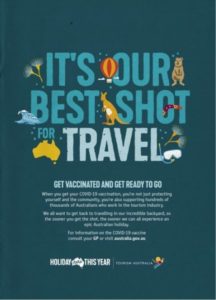 As tourism reboots with significant numbers of Europeans and Americans enjoying overseas trips for their summer holidays, Australia’s competitor destinations are reaping the financial rewards of a market that was once worth more than $45 billion a year.
As tourism reboots with significant numbers of Europeans and Americans enjoying overseas trips for their summer holidays, Australia’s competitor destinations are reaping the financial rewards of a market that was once worth more than $45 billion a year.
An Australian Financial Review report by Fiona Carruthers, Travel editor says the key 15 tourist source markets into Australia that can now travel again – such as Britain, France, Germany and the United States – have resumed 30 per cent of their pre-pandemic overseas travel rates, according to booking data crunched by travel insights and data firm ForwardKeys.
“There is demand out there,” Tourism Australia managing director Phillipa Harrison said of the latest global data, adding, “It’s just that Australia can’t capitalise on it at the moment.”
As the tourism industry foreshadows the loss of 610,000 jobs (of a total pool of 1.125 million direct and indirect roles) by the end of September, Tourism Australia is getting behind the 80 per cent vaccination target with a marketing campaign rolling out from Saturday, August 14.
 “The ‘It’s our best shot for travel’ initiative encourages people to get vaccinated and be ready to go as soon as restrictions ease,” Ms Harrison said on Friday, launching the campaign during TA’s monthly industry webinar.
“The ‘It’s our best shot for travel’ initiative encourages people to get vaccinated and be ready to go as soon as restrictions ease,” Ms Harrison said on Friday, launching the campaign during TA’s monthly industry webinar.
“Getting vaccinated is critical to tourism, but it’s bigger than that”. “It’s critical for our nation”. “We need to claim our way of life back.”
Federal Tourism Minister Dan Tehan was on hand on the webinar to “implore people to get vaccinated.”
Mr Tehan recently returned from an overseas trip that took in Singapore, Japan, South Korea and the United States, saying, “The demand to want to travel to Australia is very much still there,” adding it provided the hard-hit local industry with a ray of light.
Mr Tehan said he hoped the trans-Tasman bubble would resume by “early in the new year” and that bubbles with the Pacific islands and Singapore would quickly follow.
Japan, South Korea, the US and Great Britain are also high on the list for bubbles in early 2022.
Revisiting visa policy settings are also top of Mr Tehan’s agenda, to ensure the nation has enough international students, backpackers and the like to plug labour shortages once Australia’s external border reopens.
The government wants to “make our visas simpler to administer and apply for, to give us the edge over other countries as the place to work and travel”, Tehan said.
Tourism operators are yet to be convinced, having called for more streamlined visas for years.
With Australia’s two biggest source domestic travel markets (NSW and Victoria) now in lockdown, the washout from delta would continue to dent consumer confidence, Ms Harrison said.
“Unfortunately, the sentiment to travel will get worse before it gets better,” she said.
On current projections, Tourism Australia expects annual tourism spending to recover to only 10 to 20 per cent of its pre-pandemic levels by the end of 2022
An edited report from Australia Financial Review by John Alwyn-Jones, Special Correspondent Travel and Tourism, Global Travel Media















